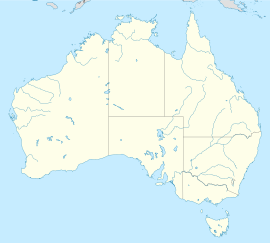Wilsons Promontory National Park
| Wilsons Promontory National Park Error: |state= not defined (help) | |
|---|---|
 | |
| Coordinates | 38°46′24″S 146°16′36″E / 38.77333°S 146.27667°E |
| Established | 1898 |
| Area | 90.00 km² |
Error: |type= not defined (help) | |
Wilsons Promontory National Park, commonly known as Wilsons Prom or The Prom, is a national park in the Gippsland region of Victoria (Australia), 157 km southeast of Melbourne.
It's mainland Australia's southernmost national park, known for its beautiful rainforests, unspoiled beaches, and abundant wildlife.
It covers the southern portion of Wilsons Promontory, a peninsula containing South Point, the southernmost point on the Australian mainland. A lighthouse on the south-east corner of the peninsula is the southern-most lighthouse on mainland Australia and has operated continuously since 1859.
A large section of the park was burnt out in April 2005 by a bushfire caused by a controlled burn that breached containment lines because of warmer and windier conditions than were forecast for that day, causing the evacuation of six-hundred people[1].
The park is highly popular with bushwalkers and campers, and has a number of lodges and serviced camping areas at a camping area near the mouth of Tidal River.
History
Indigenous Australians occupied the area at least 6,500 years ago based on archaeological records.
The first Europeans to sight Wilson's Promontory are believed to be George Bass and Matthew Flinders in 1798.
Extensive sealing took place at Sealer's Cove during the 19th Century, such that seals are no longer found there.
Lobbying by the Field Naturalists Club of Victoria and the Royal Society of Victoria (including Arthur Henry Shakespeare Lucas) led to the Government of Victoria temporarily reserve the area as National Park in 1898, made permanent in 1908. The original settlement in the Park was on the Darby River site, where a chalet existed.[2]
The Prom was used as commando training area during World War II.
Camping

The main campsite is at Tidal River, and consists primarily of unpowered sites for tents or caravans. Some cabins are also available. Booking is essential during the summer, as it is a popular holiday location.
The campsite is very close to the river and to an excellent ocean beach. Facilities include toilet and shower blocks, water near each site, a general store which sells groceries at ridiculous prices , an outdoor cinema and a visitor centre. Park rangers patrol the prom, while the medical staff deal with the medical needs of the campsite.
Camping is not permitted outside designated camping areas, and the campsites at Sealer's Cove and other locations require a permit. Numerous other regulations apply.

Wildlife

As a National Park, Wilson's Promontory is home to a wide range of wildlife species, including kangaroos, wombats, echidnas, emus, a wide range of small marsupials, and numerous species of birds, most prominent among which are the rosellas.
Generally, the wildlife around Tidal River is accustomed to human presence, and many of the animals and birds near the campsites will approach humans, accept food from them, or even enter their tents uninvited. For this reason feeding all animals has been prohibited and can even result in a fine. The rosellas around Tidal River were for many years a popular attraction, with the general store selling sunflower seed to feed them, but in recent years this practise has been banned as it disrupted the birds' lifestyle and habitat.
Outside the camping area, the wildlife is less accustomed to humans, and may be more difficult to spot. Possums can be quite easily found with a torch at night, and kangaroos and emus are often to seen in large numbers on either side of the road on the way in to the National Park.
Hiking

The Prom has many different areas in which one can hike. There are trails of differing levels of difficulty, predominantly day hikes but with one circuit hike of approximately 3 days. A permit is required for overnight hiking.
A good portion of the peninsula is rainforest. These areas are generally traversed on boardwalks and bridges. They are full of wildlife, most notably venomous snakes.
There is also some mountainous terrain. Mount Oberon affords beautiful views that are only mildly marred by a radio aerial close by.

The coastline is ruggedly beautiful with indented coves and beaches interspersed amongst granite headlands, tors and cliffs. Beaches vary from broad sandy litoral plains to steep coves and rock pools. The northern part of the park comprises a great deal of the Yanakie isthmus with sandy healthlands.
Civilisation
Wilsons Promontory is rather isolated, and the closest town is Yanakie located 36 km north of Tidal River. Yanakie is very small, and is primarily consists of a general store and the Promhill Cabins. The settlement at Tidal River, however, does have a general store, café, fish and chip shop, open-air cinema (summer months only), post boxes and public telephones.
Mount Oberon
Mount Oberon is also located in Wilsons Promontory. People usually take a vehicle halfway up the mountain and then continue on foot. A spectacular view awaits them at the top. However, it is very dangerous and is unfenced.
References
- Discover Australia's National Parks, Robert Raymond, Macmillan, Sydney, 1985
See also
External links
- Park page at Parks Victoria
- Wilson's Promontory National Park - The Science of Managing the Terrestrial Environment Contains detailed information on climate, geographical features, flora, fauna, history and land management techniques used at the park.
- Climate statistics for Australian locations - Wilson's Promontory Lighthouse Detailed observations from the weather station covering Wilson's Promontory.
- Friends of the Prom (FOTP) Volunteer group who assist park staff with preservation and upkeep.

